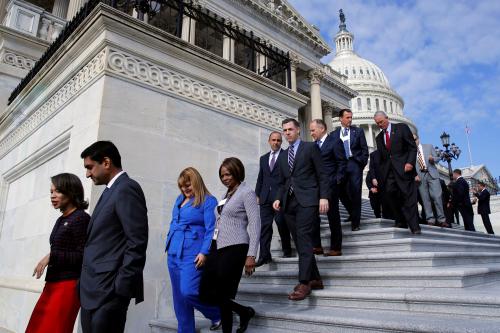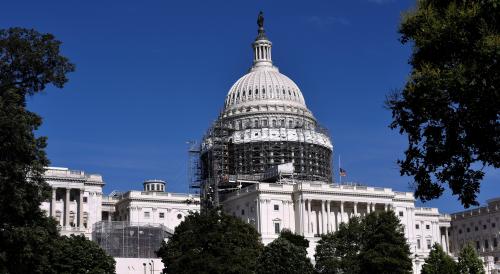How much should the United States spend on defense, and how should it spend that money?
On August 29, the Center for 21st Century Security and Intelligence brought together a panel of experts to discuss this question and more. Panelists included Alice Rivlin, a senior fellow in Brookings’s Economic Studies program and Maya MacGuineas of the Committee for a Responsible Federal Budget. They were joined by Booz-Allen-Hamilton fellow and former U.S. Department of Defense (DoD) Comptroller Robert Hale. Brookings Senior Fellow Michael O’Hanlon moderated the discussion and offered his perspective.
During the 2000s, as O’Hanlon pointed out, the U.S. national defense budget soared to around $800 billion a year (in constant 2016 dollars, including nuclear weapons activities at the Department of Energy but not Veterans Affairs or Department of Homeland Security budgets). In recent years, it has fallen to just over $600 billion annually—still a large figure relative to Cold War averages and other countries’ budgets. Further modest decreases are built into current plans, he said, but the defense budget can’t be discussed on its own these days. Rather, it’s part of a much larger sum.
Any budget considerations in 2016 and beyond need to also include broader fiscal policy, budget deficits, and national economic needs.
Contingency allocations gone awry?
Since 2011, a funding mechanism has been available under the Overseas Contingency Operations (OCO). While part of the DoD budget (and in some ways the Department of State’s, too), OCO is effectively not subject to the binding caps of the 2011 Budget Control Act.
As O’Hanlon noted, funds allocated under OCO currently amount to about $60 billion a year. The emergency supplemental appropriations that preceded OCO totaled almost $200 billion at the peak of the wars in Iraq and Afghanistan. Even at more modest levels of today, he pointed out, OCO accounts for roughly 10 percent of the Pentagon’s budget—it is clearly of great importance, even if just in terms of size.
Hale discussed the pros and cons of OCO, which he has also detailed in a recent paper: while OCO has its advantages (such as versatility and lack of caps), the next administration will need to figure out a smarter future for this account. It has been rightly criticized for effectively being exempt from budget caps, he said, yet being increasingly used to fund some “base budget” or normal DoD activities and needs. Hale argued that there are good reasons why those portions of OCO not related to war needs should go back into the base budget—but given the current caps on the base budget, he believes that is not practical.
One of the biggest challenges with OCO, argued Hale, is that it is a one-year budget. At an agency where it can already be hard to do long-term planning, even through regular channels, a one-year budget makes long-term planning all but impossible. As Speaker of the House Paul Ryan has pointed out (rightfully, in Hale’s view), using OCO for non-emergency and non-contingency purposes undermines the overall budget process.
Thinking big-picture
To that end, Hale’s larger conclusion was that we need a long-term budget deal that is not just about defense. As part of that deal, defense caps would need to be raised, probably to levels similar to amounts in the current Obama proposals. OCO would need to be maintained, but limited to actual war contingency funds.
Rivlin concurred, stating that while the defense budget is important, focusing on a specific top-line number is not the right approach. The defense budget should go up and down, depending on the threats we face. Rivlin stressed that we need to grow the U.S. economy faster, and that infrastructure modernization is essential to making economic progress writ large. The imperatives of adding jobs and growing the skilled workforce make a case for lifting the caps on domestic discretionary funds, too. Rivlin argued that any raised caps in one area (such as defense) would need to be met with raises in other areas—at the same time, it’s important to focus U.S. budget investments in high priority areas.
MacGuineas then emphasized that in security policy, the budget should be determined from the bottom up, with national security needs driving the debate. In her view, the path we are on is unsustainable: Interest payments are rising fast and do not make good investments, for one. This is a symptom of broken governance, MacGuineas concluded.
[Rivlin argued] the defense budget should go up and down, depending on the threats we face.
Up go the caps?
O’Hanlon wrapped up the discussion by making the case that real defense spending should rise modestly, as reflected in his new monograph “The $650 Billion Bargain.” Even with reforms from base closures, some new military compensation policies, and a few revisions to the nation’s weapons modernization agenda, some added resources are needed (for purposes such as ending the downsizing of the U.S. Army, for instance).
Would it be acceptable, he asked the panelists, to revise the Budget Control Act, such as by increasing current caps by 5 to 10 percent?
MacGuineas said yes, and pointed to the apparent bipartisan agreement that the caps are not reasonable. She argued for maintaining caps, however, even at higher levels, to sustain fiscal discipline. She also suggested that a revised Budget Control Act might include sequester mechanisms that would not be so unpalatable, were they to occur, and might include increased revenues rather than simple spending cuts.
Hale agreed on the notion of revising the Budget Control Act, adding that there should be more debate about the entitlements part of the budget (a point on which Rivlin and MacGuineas wholeheartedly agreed).
Rivlin, in contrast, contended that revising the Budget Control Act would be a mistake because the act itself was a mistake. Instead of working to deal with the problems of the entire budget, it focuses on less than one third of the budget. Rather than revising the act, Rivlin suggested repealing and replacing it with a broader budget process that forces Congress to think much further into the future. Controlling costs in areas like Medicare and Medicaid, as well as righting the tax code, are essential areas to consider—the defense budget is but one piece of the puzzle.
The Brookings Institution is committed to quality, independence, and impact.
We are supported by a diverse array of funders. In line with our values and policies, each Brookings publication represents the sole views of its author(s).



![An aerial view of the Pentagon building in Washington, June 15, 2005. [U.S. Defense Secretary Donald Rumsfeld defended the Guantanamo prison against critics who want it closed by saying U.S. taxpayers have a big financial stake in it and no other facility could replace it at a Pentagon briefing on Tuesday.] - RTXNK0I](https://www.brookings.edu/wp-content/uploads/2016/09/pentagon002-e1473173020271.jpg?quality=75&w=500)



Commentary
The recipe for a healthy defense budget
September 6, 2016